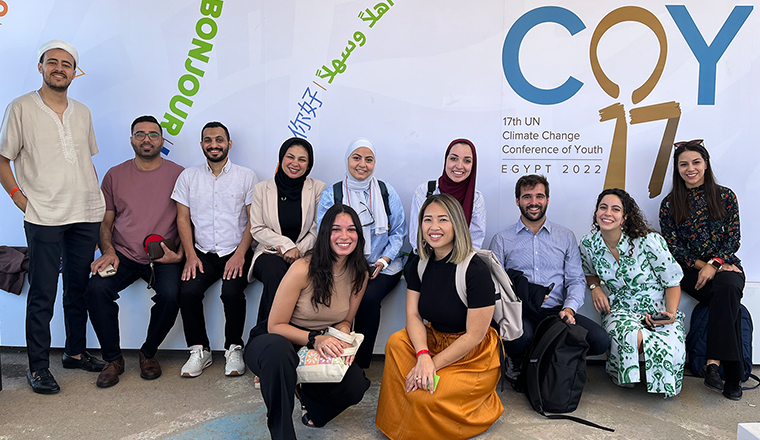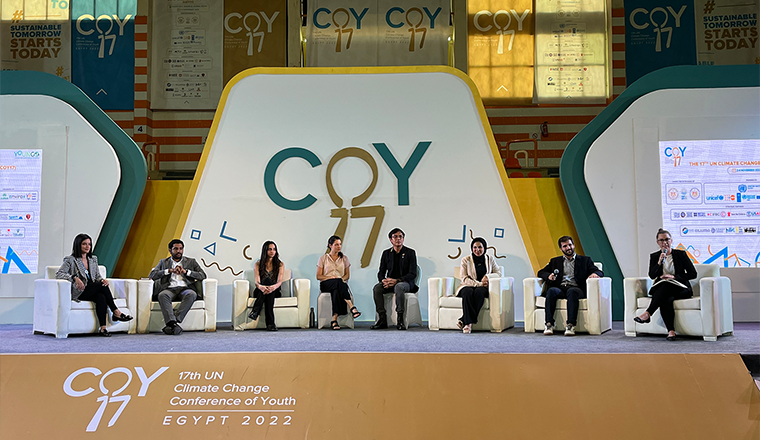- Blog
- / November 16, 2022
Mobilizing Youth for Climate Change: Live from the UN Climate Change Conference of Youth
On November 1st, Sharm El-Sheikh, the resort town between the desert of the Sinai Peninsula and the Red Sea, got ready to receive hundreds of young people from over 140 countries attending the 17th annual session of the United Nations Climate Change Conference of Youth (COY17).
After months of preparations and repairs in the exotic coastal city, including paving new roads, constructing buildings like hotels and conference halls, and renovating old facilities like the old market, the three-day event connected youth from around the world to learn and share experiences and knowledge in the climate space, as well as voice their needs and demands to decision-makers. Many of those decision-makers were close by in the negotiations rooms of the 27th annual session of the Climate Change Conference of Parties (COP27), which is taking place in Sharm El-Sheikh as well.
Follow along as Maymoona Abu-omair, a youth monitoring, evaluation and learning specialist with MSI, a Tetra Tech company, shares her perspectives on the Conference of Youth, why it’s important, and her first experience attending COY17 this year.
What is COY? A quick history!
It would be interesting if this is the first time you have heard about the COY since the “17” indicates the 17th such session and a major annual milestone for youth around the world. Gathered in one place, young people mobilize every year to organize and participate in COYs with events and gatherings prior to COPs. The two gatherings are similar in the distribution of events and their formats, but COPs are more prestigious and are more impactful in making climate policies. Hence, youth organize COYs on the sidelines of COPs because they have more opportunities to present their experiences and demands to decision-makers that are gathered in the same geographical space. For many nations and their youth, this can be a once-in-a-lifetime opportunity.
The Conference of Youth takes place in several formats every year: the Global COY takes place in person, a virtual COY is live-streamed, and regional and local COYs are organized to localize the climate conversation in many regions and countries. COYs are held under the banner of YOUNGO, the Official Children and Youth Constituency of the United Nations Framework Convention on Climate Change (UNFCCC). YOUNGO was formalized and confirmed to represent the formal voice of children and youth in UNFCCC processes.
How did I get involved in COY?
When I first heard about the Conference of Youth, the first question I had was: “how does this even happen?” Now I have my answer from first-hand experience. To attend, all you need to do is be under 35 years old, and registering is easy on the UNFCCC website. The process is clear, but the hardest part is funding. The COYs might be open to all youth to register, but a financial problem still stands among others. This is especially true for youth from poorer countries who are not able to afford the spike in prices in host countries during these events. It is also saddening to know that the countries these youth come from are those most affected by the climate crisis.
I personally come from a third-world country that is also one of the world’s most water-scarce nations: Jordan. Frankly, I would not have been able to join the conversations at COY17 and COP27 if I were not involved in the monitoring, evaluation, and learning of a climate-related project funded by USAID and implemented by MSI called MENA Youth for Climate Action (MYCA). The project offers grants and operational support to seven youth-led and/or youth-serving organizations from Egypt, Iraq, Lebanon, Tunisia, and West Bank/Gaza. The project provided an opportunity for seven representatives as well as other team members (including myself!) from MSI to be present in Sharm El-Sheikh for COY17 and COP27.
What can you do at COY?
You might be thinking, this all sounds great, but what do you actually do at this event? Valid question! Over three days, there were more than 60 events taking place in the Olympic village. You could visit the main auditorium for panels, training rooms or one of the six halls for workshops, the meeting halls for meetings, or the outdoor arena for some fresh air. I attended seven different events: four panel discussions and three workshops, all focused on skill and capacity building as well as raising awareness and calling for action from people of power.
You can also take part on a higher level as a speaker in a panel discussion or a facilitator at a workshop or training. The many partner organizations hosting events open calls for applications for potential speakers at their own events. Even if your application doesn’t get accepted, don’t give up! Many organizations might contact you a few days before the Conference because they have an extra slot due to some last-minute scheduling changes.
Two of the MYCA grantees were nominated to speak about their experiences with their organizations and the MYCA project during a panel discussion about intergenerational dialogues regarding climate action. Donors USAID, UNICEF, and the Swiss Agency for Development and Cooperation (SDC) also participated in the panel, as well as three more youth speakers from around the world. The youth speakers provided inputs about their experiences with donor-funded climate projects, lessons learned, and challenges, while the donors provided outputs about their strategies and future plans in the climate space.
11 members of MSI’s delegation to the 17th UN Climate Change Conference of Youth pose for a group photo.
Two of the MENA Youth for Climate Action grantees spoke about their experience during a panel at COY17.
Representatives from donor agencies including USAID, UNICEF and the Swiss Agency for Development and Cooperation also participated in the panel.

11 members of MSI's delegation to the 17th UN Climate Change Conference of Youth pose for a group photo.

Two of the MENA Youth for Climate Action grantees spoke about their experience during a panel at COY17.

Representatives from donor agencies including USAID, UNICEF and the Swiss Agency for Development and Cooperation also participated in the panel.
What could’ve been better?
One key challenge I noticed when we were preparing to come to Egypt was the lack of promotion and low visibility of the Conference of Youth, despite it being regarded as a key element to the negotiations at COP27. This was even more apparent when I arrived in Sharm El-Sheikh, where the billboards and all the signs on the streets were branded with the COP27 logo, and COY17 was nowhere to be seen. “This is not the same Sharm from 4 or 5 months ago!” one cab driver said wittily, “If they host a conference in Egypt every year, but in different cities, then I wouldn’t want anything else in the world!” he continues, pointing out to me all the newly constructed facilities and buildings “because of the conference!”.
The Conference of Youth was a success with hundreds of youths gathered in one place with one common goal to save the Earth. However, there were some logistical, organizational, and technical issues that hindered learning and knowledge-sharing in some venues. Some halls had bad acoustics, bad audio systems, weak wi-fi connection, or noise canceling from other neighboring halls. Sometimes events would be announced last minute on the same day of the sessions, despite there being an agenda for each day with the events, time and halls assigned. The general sense was that the COY, as a youth-only event, was overshadowed by the COP, resulting in the lack of visibility and the occurrence of technical issues despite there being months of preparation for the event.
I also noticed the high visibility of the government of Egypt during the COY, including the President attending the opening ceremony as well as many panel discussions, especially those hosted by Egyptian affiliates. “Well, this COY is co-hosted by the government this time, unlike the previous ones,” a colleague said when I pointed it out. I felt that the youth and their capacities and needs should have been given the spotlight. Some youth climate organizations protested COP27 being hosted in Egypt because of the “authoritarian” regime. I also found out that several organizations were denied access to COP27 with no further explanation for why.
Would I go to COY in the future?
Definitely! In addition to the learning exchange and knowledge sharing which happens on a regular basis in conferences like these, the best part of COY is connecting with peers and colleagues who share your aspirations and fears for the future of the planet. I met with YOUNGO representatives to discuss lessons learned, challenges and recommendations as a youth myself! I connected with one of the youth negotiators from the Tunisian delegation to COP27, and we discussed the gaps in the knowledge of climate finance, as this is part of my interests and an opportunity to integrate learning into the MYCA project. Witnessing COY17 coming to life was a great experience, and it made me appreciate the people behind the scenes who made the COY possible for us to connect and try to make a difference. If you can attend the next COY, you should take the chance and go, because you never know when you might find an opportunity to make a positive change!